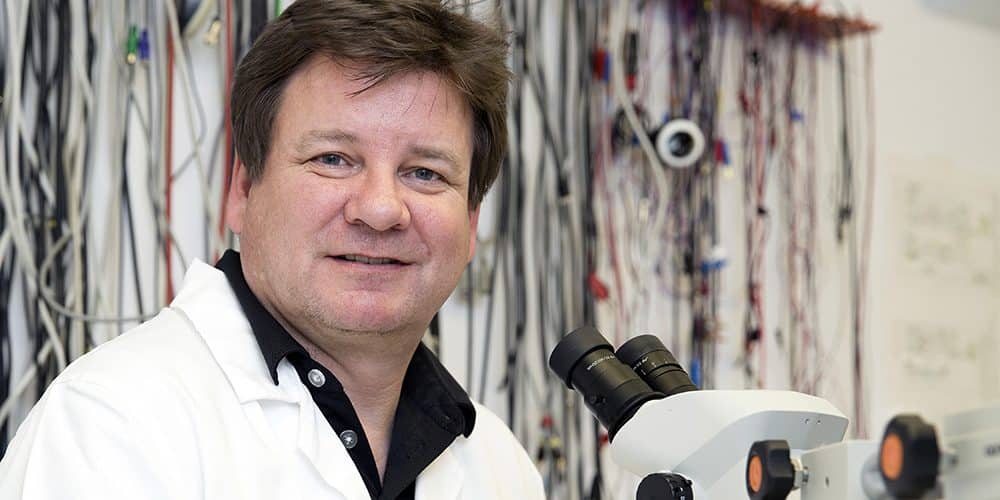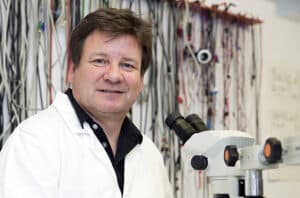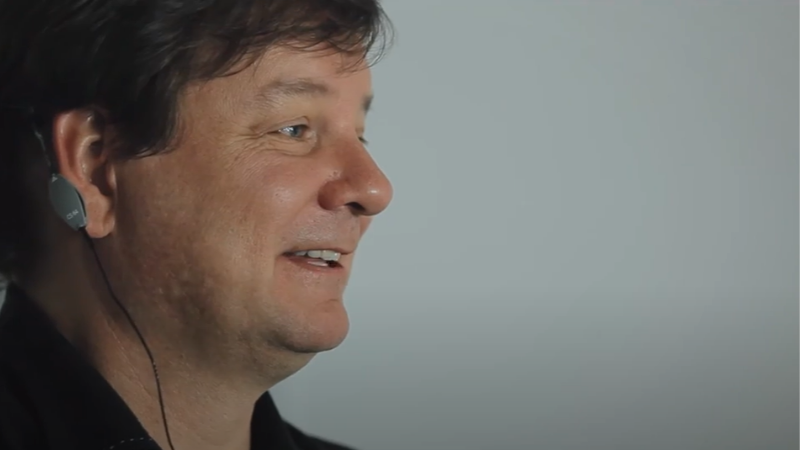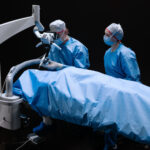
MED-EL
Published Jun 15, 2016 | Nov 14, 2024
Geoff Ball: The Inventor of the VIBRANT SOUNDBRIDGE
Geoffrey Ball is the inventor of VIBRANT SOUNDBRIDGE—and a SOUNDBRIDGE recipient himself. He developed hearing loss at an early age. After trying various hearing aids, the solution was obvious: he needed to build a device that worked with what little hearing he had left. Find out how Geoff turned his personal challenge into a revolutionary creation that has impacted countless lives.

Biomedical Innovation in Silicon Valley
MED-EL Blog: Thanks for sitting down with us, Geoffrey. Could you start by sharing a little bit about you, your background, and your experience?
Geoff Ball: I’m from Sunnyvale, California, in the heart of Silicon Valley. After graduating with a Bachelor’s in Physiology and a Master’s in Information Technology, I was hired immediately out of school as a biomedical engineer at the Stanford University School of Medicine. I ran the lab for seven years, and at the same time, I also did a lot of consulting work with medical device and electronics companies.
The Resilience to Overcome Challenges
MB: Could you tell us a bit about your hearing loss?
GB: I became deaf after a series of high fevers and illnesses that I experienced between the ages of 3 and 4 years old. Part of treating the fevers was an injection of an antibiotic, most likely gentamicin, which we now know to be ototoxic [damaging to the ears]. Likely because of that, I have a -80 dB sensorineural deafness, which means I can hear extremely loud sounds such as car horns, but I cannot hear much else without amplification.
The audiologists in the US call my type of hearing loss “moderately severe hearing loss,” but that has always made me a bit crazy.

I always think to myself, “There is just nothing ‘moderate’ about being unable to hear. Period.”
Geoff Ball
Inventor and user of VIBRANT SOUNDBRIDGE
From Early Hearing Aids to a Modern Cochlear Implant
MB: What sorts of treatments were available for your hearing loss?
GB: When I was a child, the only option was an acoustic hearing aid. Until the mid-1980s, hearing aids were truly terrible devices. They amplified all sounds without making anything clearer. In 1978, I read about cochlear implants and knew I wanted one. Although I had to wait 18 years for an implant, I finally got it. I was with my first VIBRANT SOUNDBRIDGE (right ear) in 1997 and my second (left ear) in 2000 immediately after US FDA approval. In 2015, I was implanted (left ear) with the next-generation 503 Floating Mass Transducer.
Bridging the Gap Between Hearing Solutions
MB: Why did you want to develop a new type of hearing implant?
GB: Working across from the ophthalmology department at Stanford, I saw many treatment options for vision problems, but for deafness, it was just hearing aids or nothing. With the arrival of cochlear implants, there was hope for more solutions. My experience at Stanford motivated me to work on a new hearing implant.
Developing the Middle-Ear Implant: Journey From Concept to Creation
MB: How did you actually go about developing a middle ear implant?
GB: It took seven or eight years of intense work in windowless labs at Stanford. I tested ears, built new test systems, and tried hundreds of devices. One night, working in my garage, I discovered the Floating Mass Transducer (FMT), which could be connected to the middle ear bones to create sound vibrations loud enough to be heard.
The Impact of VIBRANT SOUNDBRIDGE
MB: What is it like to have invented the implant that enables you to hear?
GB: I was implanted with one of the first clinical trial units, which meant that it was only supposed to be for the clinical trial. The fact that it is still working and has worked so well for so many years is amazing.
When I had my implantation, I heard with my own device in my own head for the first time. Yeah, it was very cool, I have to admit. And every now and then when I switch my implants on and can hear, I think to myself, “Wow, that is really awesome!”

It is humbling to me because I know how much hard trial-and-error effort went into it, and I am happy to be part of it.
Geoff Ball
Inventor and user of VIBRANT SOUNDBRIDGE
And I mean only one part of it, because there have been hundreds of researchers, doctors, business experts, regulatory specialists, and clinical support staff who have made this happen. No one person could ever have done it all.
The Second SOUNDBRIDGE Implant
MB: You received a new SOUNDBRIDGE in 2015. Why did you wait so long?
GB: It’s because the newest SOUNDBRIDGE implant has some new improvements that I wanted to try out. One is that it is now “MR conditional,” which is regulatory language meaning it can go through 1.5 Tesla MRI. And we also invented a newer attachment method where the FMT connects to my middle ear bones, and I really wanted to hear how it compared to the other method.
A Cochlear Implant as a Bilateral Solution
MB: Why did you get a cochlear implant 4 years later?
GB: In 2019, my hearing in my right ear went down by 15-20 dB after a chronic tinnitus episode, and I was implanted with a cochlear implant.
Cochlear Implant vs. VIBRANT SOUNDBRIDGE
MB: How does your hearing with VSB compare to your hearing with a CI?
GB: My cochlear implant had to be fine-tuned and programmed for speech and music first. Also, hearing training was necessary with my CI. I still take 2 hours a week for speech training. primarily needs major amplitude, especially for speech understanding in quiet, cochlear implants are tough to beat—my score with a cochlear implant is perfect (100%). For speech in noise, my VIBRANT SOUNDBRIDGE was awesome.
Geoff’s Advice to Others With Hearing Loss
MB: Which advice could you give to other people with hearing loss?
GB: Don’t wait for new technology to get implanted with a hearing implant. Miracles happen today, not next week!
Thanks, Geoff!
Geoff Ball’s autobiography, “No More Laughing at the Deaf Boy”, released in 2011, shares his adventure in technology leading him from Silicon Valley in California to Austria, where he now lives and continues his work with MED-EL.
Want to hear more from Geoff? Check out this video of him explaining—and receiving—the newest SOUNDBRIDGE implant that he helped develop.
References

MED-EL
Was this article helpful?
Thanks for your feedback.
Sign up for newsletter below for more.
Thanks for your feedback.
Please leave your message below.
Thanks for your message. We will reply as soon as possible.
Send us a message
Field is required
John Doe
Field is required
name@mail.com
Field is required
What do you think?
© MED-EL Medical Electronics. All rights reserved. The content on this website is for general informational purposes only and should not be taken as medical advice. Contact your doctor or hearing specialist to learn what type of hearing solution suits your specific needs. Not all products, features, or indications are approved in all countries.
Abel González
March 01, 2025
Me gustaría que me ofrecieran información importante sobre el vibrante sounbrigde . Tengo hipoacusia neurosensorial bilateral severa y no ou acto para implante coclear ni para implante oseointegrado y los audífonos no me dan el resultado que necesito no entiendo bien con ellos por eso quería saber sobre este implante de oído medio so sería aco para mí espero su pronta repuesta muchas gracias
MED-EL
March 03, 2025
Hola Abel, Gracias por tu interés en VIBRANT SOUNDBRIDGE. Si es posible, te invitamos a ponerte en contacto con tu equipo local de MED-EL, de forma que puedan ayudarte personalmente. Si estás en España, por favor, contacta a través de: https://www.medel.com/es-es/contact-med-el Si estás en LATAM, por favor, usa este formulario: https://www.medel.com/latam/contact-med-el Un afectuoso saludo

MED-EL

MED-EL




Conversation
1 Comment